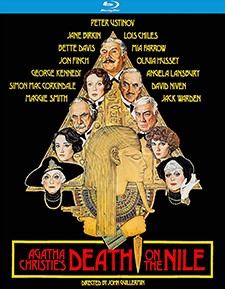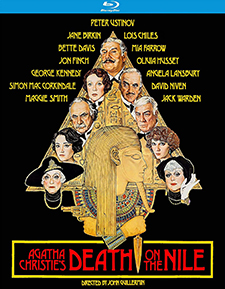Death on the Nile (1978) (Blu-ray Review)

Director
John GuillermanRelease Date(s)
1978 (September 1, 2020)Studio(s)
Mersham Productions/EMI Films/Paramount Pictures (Kino Lorber Studio Classics)- Film/Program Grade: A-
- Video Grade: A
- Audio Grade: A
- Extras Grade: B-
Review
Death on the Nile, based on a novel by Agatha Christie, is a lush follow-up to 1974’s Murder on the Orient Express. Peter Ustinov stars as Belgian detective Hercule Poirot (taking over for Albert Finney), on vacation in Egypt. The action takes place mostly aboard a luxurious steamer chugging to points of interest along the Nile. The passengers on board include honeymooners Linnet Ridgeway (Lois Chiles) and Simon Doyle (Simon MacCorkindale), and an assortment of colorful characters, some of whom have a personal interest in this couple.
Among the passengers are the Ridgeway family’s lawyer, Andrew Pennington (George Kennedy); romance novel author Salome Otterborne (Angela Lansbury); Mrs. Van Schuyler (Bette Davis), a dowager with an eye for expensive jewelry, and her companion, Miss Bowers (Maggie Smith); Mrs. Otterborne’s daughter Rosalie (Olivia Hussey); Linnet’s personal maid, Louise Bourget (Jane Birkin); Col. Race (David Niven), on board to see that Linnet’s financial affairs are not threatened; Ludwig Bessner (Jack Warden), a physician with a dubious past; and Jacqueline De Bellefort (Mia Farrow), Simon’s jilted fiancee.
In the midst of an enviable tour through historical sites and breathtaking scenery, Linnet is murdered in her bed. Poirot and Col. Race combine forces to investigate and learn that everyone on board has a reason to have murdered Linnet. This complication keeps us continuously guessing as one revelation after another point to different suspects.
Under the direction of John Guillerman, the film looks fantastic, with authentic Egyptian locations, 1930s period costumes, and cinematographer Jack Cardiff’s impressive views of the steamer on the Nile, a massive Egyptian ruin, the Sphinx, and the great pyramids. Conventions of the mystery genre are observed by keeping a wide group of characters together and providing each with a motive for murder.
Ustinov is amusing as the rotund detective, equally enthusiastic about dipping a croissant in his coffee as he is about discovering clues and piecing together bits of apparently insignificant information. Whether twirling his distinctive mustache, dozing off after a full meal, secretly observing various fellow passengers, or sauntering the deck of the steamer, he offers a humorous portrayal of the famous detective whose reputation and penchant for deduction have turned his vacation into yet another complicated case to be solved.
The film holds the viewer’s attention with uniformly first-rate performances. Angela Lansbury is particularly notable with Salome’s flamboyance, heavy drinking, and ostentatious wardrobe. The role calls for her to be over the top, and she doesn’t disappoint. Mia Farrow plays the obsessed Jacqueline sympathetically. She is rightfully hurt by Simon’s dropping her for Linnet and has thought of nothing else but making their lives miserable. Bette Davis is appropriately imperious as Mrs. Van Schuyler and has a few comic scenes with Maggie Smith, whose Miss Bowers resents having to wait on her hand and foot and makes her displeasure abundantly apparent. David Niven brings British elegance to his role, serving to provide exposition and keep the viewer apprised of the ongoing ramifications of the murder investigation.
Overly long at two hours, twenty minutes, the film has scenes that seem padded, such as when the manager of the Karnak (I.S. Johar) greets the passengers as they board. He attempts to guess who each is based on his manifest, blundering and testing their patience (and ours). Intended for comic relief, the scene stops the film dead and could easily have been cut. A tango scene that takes place at the hotel prior to the voyage, though charmingly awkward, also could have been deleted to make for a more streamlined narrative.
Mystery fans will thoroughly enjoy Death on the Nile and movie fans will appreciate the tender loving care given to its casting, production design, photography, and Nino Rota’s score. The all-star cast makes this a classy ensemble piece.
Featuring 1080p resolution, the new 2K restoration of the film from Kino Lorber Studio Classics is presented in the widescreen aspect ratio of 1.85:1. The picture is pristine and vibrant. Details pop, such as the sparkles in Linnet’s low-cut silver dress, the heavily made up and accessorized Mrs. Otterborne, hieroglyphics on Egyptian columns, bark on palm trees, and grain in wood paneling on the steamer. The women’s period costumes are particular stand-outs, with rich fabrics, large feathered hats, and matching parasols. Horse-drawn carriages, camels, and donkeys add to local color and help establish the time period. Linnet and Simon on horseback galloping in front of the great pyramids is particularly memorable.
The soundtrack is English Mono DTS-High Definition Master Audio. Subtitles in English SDH are also available. Dialogue is uniformly distinct. Despite Poirot’s Belgian accent, Dr. Bessner’s German accent, and Mrs. Otterborne’s sloshed utterances, they all make their dialogue easily understood. Bette Davis speaks in the clipped manner that was her trademark in her later films. Her behavior is part condescending, part combative. A lilting instrumental rendition of I’ve Got a Feeling You’re Fooling plays in the expansive hotel lobby and a brief tango adds a comic moment. The steamer’s horn and paddle wheel add appropriate ambient sound. Street scenes in the early part of the film are crowded and noisy, but these background sounds are well balanced with dialogue. Silence is dramatically effective when the characters meander through an Egyptian ruin in separate groupings behind giant pillars and into and out of shadows. We know something is about to happen, but not when or how, and the suspense and tension grow. Gunshots sound tinny because they are from a small-caliber gun. There was apparently no attempt to “sweeten” them for dramatic impact.
Bonus materials include an audio commentary, making-of featurette, interviews with Peter Ustinov and Jane Birkin, reversible cover art, teaser, and several trailers.
Audio Commentary – The commentary is shared by film historians Howard S. Berger, Steve Mitchell, and Nathaniel Thompson. Death on the Nile is the second in a series of four British Agatha Christie adaptations. The first, Murder on the Orient Express, was a “really big deal” and a huge hit. Death on the Nile is a more intimate film than those John Guillerman—known for “more muscular work”—had directed. Scenes are beautifully composed by cinematographer Jack Cardiff. The portrayals of Hercule Poirot by Albert Finney in Murder on the Orient Express and Peter Ustinov in Death on the Nile are compared. Both are valid, based on Christie’s descriptions of the detective. The film was shot on locations throughout Egypt in “torturous heat.” Because we see considerable footage of the cast in Egypt, it’s easy to accept the studio-built Karnak steamer. The “neo-Wagnerian” score by Nino Rota is a musical reference to engines chugging down the river. At other points, the score is romantic and full of life. Rota’s score for The Godfather made his work known to American audiences. The Christie films are evergreens—always available on home video and television. Guillerman makes the film elegant in its simplicity, creating rhythm and pace. Camera movements are artistically conceived with long master shots, tracking shots, and the camera moving around characters. Ordinary cutting would have involved several shots edited together to create a scene but would have created a choppy effect, diluting suspense. The final scene is true to Christie, with Poirot establishing his own version of a courtroom in a room aboard the steamer. Master shots are used because the assembled characters represent the jury.
Making of Death on the Nile – The set of the Nile at night was constructed at Pinewood Studios in England. Technicians made a copy of the steamer that the filmmakers found in Cairo and used for location scenes. Agatha Christie wasn’t keen on having Death on the Nile adapted into a film because she was displeased with previous screen adaptations of her work. Peter Ustinov discusses Christie’s concept of Hercule Poirot. He felt he was able to add his distinctive touch to his portrayal. The Christie formula is always the same, with an interesting setting the centerpiece for the whodunit. David Niven and Jon Finch discuss their characters. We see several behind-the-scenes shots of set construction. Water tanks simulated the Nile River for studio filming. Much work had to be done on the actual steamer to make it look good on camera. Numerous photos of the steamer were taken so it could be duplicated in the studio. Of the cast, it’s observed that “the more egos you have, the less trouble” there is because every actor wants to be seen as professional.
Interview with Peter Ustinov – This odd interview, which takes place with London’s Tower Bridge in the background, is conducted in Spanish (with English subtitles). Ustinov responds in Spanish and comments, “Poirot understands everything, sees everything. He’s always listening, watching.” On request, Ustinov imitates the sound of a bassoon.
Interview with Jane Birkin – This interview, also filmed with Tower Bridge in the background, is conducted by the same man, partly in English, partly in Spanish. Birkin, who plays Louise Bourget, speaks about her singing career and discusses the kind of music she likes.
Trailers – Seven trailers are included: Death on the Nile, Evil Under the Sun, The Mirror Crack’d, Witness for the Prosecution, Endless Night, Ordeal by Innocence, and Ten Little Indians.
– Dennis Seuling

